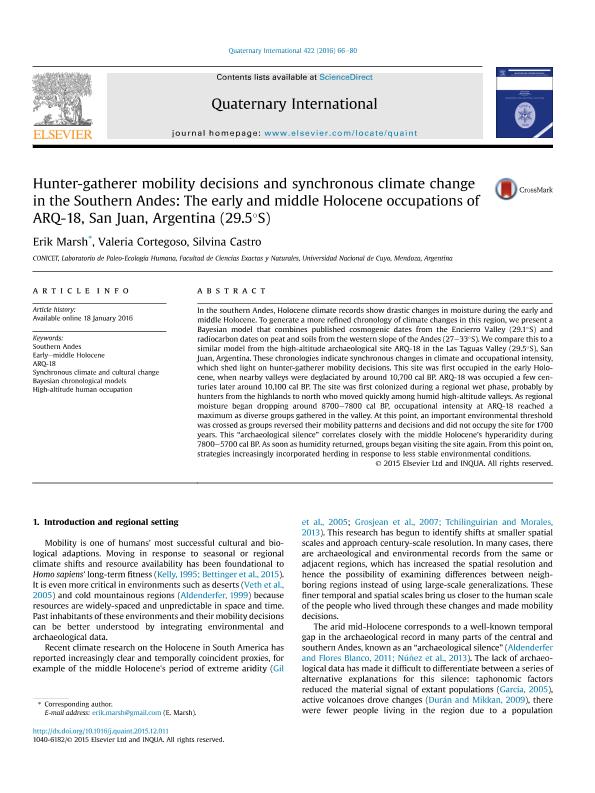Mostrar el registro sencillo del ítem
dc.contributor.author
Marsh, Erik Johnson

dc.contributor.author
Cortegoso, Valeria

dc.contributor.author
Castro, Silvina Celeste

dc.date.available
2018-09-13T15:51:49Z
dc.date.issued
2016-11
dc.identifier.citation
Marsh, Erik Johnson; Cortegoso, Valeria; Castro, Silvina Celeste; Hunter-gatherer mobility decisions and synchronous climate change in the Southern Andes: The early and middle Holocene occupations of ARQ-18, San Juan, Argentina (29.5°S); Pergamon-Elsevier Science Ltd; Quaternary International; 422; 11-2016; 66-80
dc.identifier.issn
1040-6182
dc.identifier.uri
http://hdl.handle.net/11336/59504
dc.description.abstract
In the southern Andes, Holocene climate records show drastic changes in moisture during the early and middle Holocene. To generate a more refined chronology of climate changes in this region, we present a Bayesian model that combines published cosmogenic dates from the Encierro Valley (29.1°S) and radiocarbon dates on peat and soils from the western slope of the Andes (27–33°S). We compare this to a similar model from the high-altitude archaeological site ARQ-18 in the Las Taguas Valley (29.5°S), San Juan, Argentina. These chronologies indicate synchronous changes in climate and occupational intensity, which shed light on hunter-gatherer mobility decisions. This site was first occupied in the early Holocene, when nearby valleys were deglaciated by around 10,700 cal BP. ARQ-18 was occupied a few centuries later around 10,100 cal BP. The site was first colonized during a regional wet phase, probably by hunters from the highlands to north who moved quickly among humid high-altitude valleys. As regional moisture began dropping around 8700–7800 cal BP, occupational intensity at ARQ-18 reached a maximum as diverse groups gathered in the valley. At this point, an important environmental threshold was crossed as groups reversed their mobility patterns and decisions and did not occupy the site for 1700 years. This “archaeological silence” correlates closely with the middle Holocene's hyperaridity during 7800–5700 cal BP. As soon as humidity returned, groups began visiting the site again. From this point on, strategies increasingly incorporated herding in response to less stable environmental conditions.
dc.format
application/pdf
dc.language.iso
eng
dc.publisher
Pergamon-Elsevier Science Ltd

dc.rights
info:eu-repo/semantics/openAccess
dc.rights.uri
https://creativecommons.org/licenses/by-nc-sa/2.5/ar/
dc.subject
Arq-18
dc.subject
Bayesian Chronological Models
dc.subject
Early&Ndash;Middle Holocene
dc.subject
High-Altitude Human Occupation
dc.subject
Southern Andes
dc.subject
Synchronous Climate And Cultural Change
dc.subject.classification
Historia

dc.subject.classification
Historia y Arqueología

dc.subject.classification
HUMANIDADES

dc.title
Hunter-gatherer mobility decisions and synchronous climate change in the Southern Andes: The early and middle Holocene occupations of ARQ-18, San Juan, Argentina (29.5°S)
dc.type
info:eu-repo/semantics/article
dc.type
info:ar-repo/semantics/artículo
dc.type
info:eu-repo/semantics/publishedVersion
dc.date.updated
2018-09-12T14:01:40Z
dc.journal.volume
422
dc.journal.pagination
66-80
dc.journal.pais
Estados Unidos

dc.journal.ciudad
Nueva York
dc.description.fil
Fil: Marsh, Erik Johnson. Consejo Nacional de Investigaciones Científicas y Técnicas; Argentina. Universidad Nacional de Cuyo. Facultad de Ciencias Exactas y Naturales. Laboratorio de Paleoecología Humana; Argentina
dc.description.fil
Fil: Cortegoso, Valeria. Consejo Nacional de Investigaciones Científicas y Técnicas; Argentina. Universidad Nacional de Cuyo. Facultad de Ciencias Exactas y Naturales. Laboratorio de Paleoecología Humana; Argentina
dc.description.fil
Fil: Castro, Silvina Celeste. Consejo Nacional de Investigaciones Científicas y Técnicas; Argentina. Universidad Nacional de Cuyo. Facultad de Ciencias Exactas y Naturales. Laboratorio de Paleoecología Humana; Argentina
dc.journal.title
Quaternary International

dc.relation.alternativeid
info:eu-repo/semantics/altIdentifier/doi/https://dx.doi.org/10.1016/j.quaint.2015.12.011
dc.relation.alternativeid
info:eu-repo/semantics/altIdentifier/url/https://www.sciencedirect.com/science/article/pii/S104061821530063X
Archivos asociados
